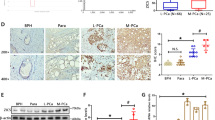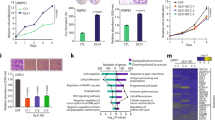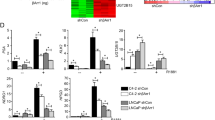Abstract
The pro-oncogene FBI-1, encoded by Zbtb7a, is a transcriptional repressor that belongs to the POK (POZ/BTB and Krüppel) protein family. In this study, we investigated a potential interaction between androgen receptor (AR) signaling and FBI-1 and demonstrated that overexpression of FBI-1 inhibited ligand-dependent AR activation. A protein–protein interaction was identified between FBI-1 and AR in a ligand-dependent manner. Furthermore, FBI-1, AR and SMRT formed a ternary complex and FBI-1 enhanced the recruitment of NCoR and SMRT to endogenous PSA upstream sequences. Our data also indicated that the FBI-1-mediated inhibition of AR transcriptional activity is partially dependent on HDAC. Interestingly, FBI-1 plays distinct roles in regulating LNCaP (androgen-dependent) and PC-3 cell (androgen-independent) proliferation.








Similar content being viewed by others
References
Tsai MJ, O’Malley BW (1994) Molecular mechanisms of action of steroid/thyroid receptor superfamily members. Annu Rev Biochem 63:451–486
White R, Parker MG (1998) Molecular mechanisms of steroid hormone action. Endocr Relat Cancer 5:1–14
Lavery DN, McEwan IJ (2006) The human androgen receptor AF1 transactivation domain: interactions with transcription factor IIF and molten-globule-like structural characteristics. Biochem Soc Trans 34:1054–1057
Gelmann EP (2002) Molecular biology of the androgen receptor. J Clin Oncol 20:3001–3015
Chen G, Nomura M, Morinaga H, Matsubara E, Okabe T, Goto K, Yanase T, Zheng H, Lu J, Nawata H (2005) Modulation of androgen receptor transactivation by FoxH1, a newly identified androgen receptor corepressor. J Biol Chem 280:36355–36363
Heinlein CA, Chang C (2002) Androgen receptor (AR) coregulators: an overview. Endocr Rev 23:175–200
Maeda T, Hobbs RM, Pandolfi PP (2005) The transcription factor Pokemon: a new key player in caner pathogenesis. Cancer Res 65:8575–8578
Koh DI, Choi WI, Jeon BN, Lee CE, Yun CE, Hur MW (2009) A novel POK family transcription factor, ZBTB5, represses transcription of p21CIP1 gene. J Biol Chem 284:19856–19866
Lee DK, Suh D, Edenberg HJ, Hur MW (2002) POZ domain transcription factor, FBI-1, repress transcription of ADH5/FDH by interacting with the zinc finger and interfering with DNA binding activity of SP1. J Biol Chem 277:26761–26768
Maeda T, Merghoub T, Hobbs RM, Dong L, Maeda M, Zakrzewski J, van den Brink MR, Zelent A, Shigematsu H, Akashi K (2007) Regulation of B versus T lymphoid lineage fate decision by the proto-oncogene LRF. Science 316:860–866
Maeda T, Hobbs RM, Merghoub T, Guernah I, Zelent A, Cardon-Cardo C, Teruya-Feldstein J, Pandolfi PP (2005) Role of the proto-oncogene Pokemon in cellular transformation and ARF repression. Nature 433:278–285
Jeon BN, Yoo JY, Choi WI, Lee CE, Yoon HG, Hur MW (2008) Proto-oncogene FBI-1 (Pokemon/ZBTB7A) represses transcription of the tumor suppressor Rb gene via binding competition with Sp1 and recruitment of co-repressors. J Biol Chem 283:33199–33210
Choi WI, Jeon BN, Park H, Yoo JY, Kim YS, Koh DI, Kim MH, Kim YR, Lee CE, Kim KS (2008) Proto-oncogene FBI-1 (Pokemon) and SREBP-1 synergistically activate transcription of fatty-acid synthase gene (FASN). J Biol Chem 283:29341–29354
Cleutjens KB, van der Korput HA, van Eekelen CC, van Rooij HC, Faber PW, Trapman J (1997) An androgen response element in a far upstream enhancer region is essential for high androgen regulated activity of the prostate specific antigen promoter. Mol Endocrinol 11:148–161
Yu C, Markan K, Temple KA, Deplewski D, Brady MJ, Cohen RN (2005) The nuclear receptor corepressors NCoR and SMRT decrease peroxisome proliferator-activated receptor γ transcriptional activity and repress 3T3-L1 adipogenesis. J Biol Chem 280:13600–13605
Yoon HG, Wong J (2006) The corepressors silencing mediator of retinoid and thyroid hormone receptor and nuclear receptor corepressor are involved in agonist and antagonist regulated transcription by androgen receptor. Mol Endocrinol 20:1048–1060
Shang Y, Myers M, Brown M (2002) Formation of the androgen receptor transcription complex. Mol Cell 9:601–610
Louie MC, Yang HQ, Ma AH, Xu W, Zou JX, Kung HJ, Chen HW (2003) Androgen-induced recruitment of RNA polymerase II to a nuclear receptor p160 coactivator complex. Proc Natl Acad Sci USA 100:2226–2230
Huynh KD, Bardwell VJ (1998) The BCL-6 POZ domain and other POZ domains interact with the co-repressors NCoR and SMRT. Oncogene 17:2473–2484
Ma QP, Fu W, Li PF, Nicosia SV, Jenster G, Zhang XH, Bai WL (2009) FoxO1 Mediates PTEN suppression of androgen receptor N- and C-terminal interactions and coactivator recruitment. Mol Endocrinol 23:213–215
Choi WI, Jeon BN, Kim PH, Kim SE, Choi KY, Kim SH, Hur MW (2009) Proto-oncogene FBI-1 represses transcription of p21CIP1 by inhibition of transcription activation by p53 and Sp1. J Biol Chem 284:12633–12644
Han X, JH GUO, Deng WW, Zhang CY, Du P, Shi TP, Ma DL (2008) High-throughput cell based screening reveals a role for ZNF131 as a repressor of ER alpha signaling. BMC Genomics 9:476–485
Jiang F, Wang Z (2004) Identification and characterization of PLZF as a prostatic androgen responsive gene. Prostate 59:426–435
Pike J, Holmes D, Kamalati T, Davies D, Tolhurst R, Mazhar D, Fishpool S, Jehani R, Waxman J, Zelent A, Lemoine NR, Ali S, Buluwela L (2004) Silencing of androgen regulated genes using a fusion of AR with the PLZF transcriptional repressor. Oncogene 23:7561–7570
Burd CJ, Morey LM, Knudsen KE (2006) Androgen receptor corepressors and prostate cancer. Endocr Relat Cancer 13:979–994
Heemers HV, Tindall DJ (2007) Androgen receptor (AR) coregulators: a diversity of functions converging on and regulating the AR transcriptional complex. Endocr Rev 28:778–808
Guenther MG, Barak O, Lazar MA (2001) The SMRT and NCoR corepressors are activating cofactors for histone deacetylase 3. Mol Cell Biol 21:6091–6101
Hodgson MC, Astapova I, Cheng S, Lee LJ, Verhoeven MC, Choi E, Balk SP, Hollenberg AN (2005) The androgen receptor recruits nuclear receptor corepressor (NCoR) in the presence of mifepristone via its N and C termini revealing a novel molecular mechanism for androgen receptor antagonists. J Biol Chem 280:6511–6519
Laudes M, Bilkovski R, Oberhauser F, Droste A, Gomolka M, Lesser U, Udelhoven M, Krone W (2008) Transcription factor FBI-1 acts as a dual regulator in adipogenesis by coordinated regulation of cyclin-A and E2F-4. J Mol Med 86:597–608
Yamamoto A, Hashimoto Y, Kohri K, Ogata E, Kato S, Ikeda K, Nakanishi M (2000) Cyclin E as a coactivator of the androgen receptor. J Cell Biol 150:873–880
Lim JT, Mansukhani M, Weinstein IB (2005) Cyclin-dependent kinase 6 associates with the androgen receptor and enhances its transcriptional activity in prostate cancer cells. Proc Natl Acad Sci USA 102:5156–51561
Fan WQ, Yanase T, Morinaga H, Okabe T, Nomura M, Daitoku H, Fukamizu A, Kato S, Takayanagi R, Nawata H (2007) Insulin-like growth factor 1/insulin signaling activates androgen signaling through direct interactions of Foxo1 with androgen receptor. J Biol Chem 282:7329–7338
Zheng Y, Chen WL, Ma WL, Chang C, Ou JH (2007) Enhancement of gene transactivation activity of androgen receptor by hepatitis B virus X protein. Virology 363:454–461
Petre CE, Wetherill YB, Danielsen M, Knudsen KE (2002) Cyclin D1: mechanism and consequence of androgen receptor co-repressor activity. J Biol Chem 277:2207–2215
Petre CE, Williams EB, Burd CJ, Gladden A, Moghadam H, Meller J, Diehl JA, Knudsen KE (2005) A central domain of cyclin D1 mediates nuclear receptor corepressor activity. Oncogene 24:431–444
Chen SY, Cai C, Fisher CJ, Zheng Z, Omwancha J, Hsieh CL, Shemshedini L (2006) c-Jun enhancement of androgen receptor transactivation is associated with prostate cancer cell proliferation. Oncogene 25:7212–7223
Chiu YT, Han HY, Leung SC, Yuen HF, Chau CW, Guo ZY, Qiu Y, Chan KW, Wang XH, Wong YC (2009) CDC25A functions as a novel AR corepressor in prostate cancer cells. J Mol Biol 385:446–456
Jiang F, Wang Z (2004) Identification and characterization of PLZF as a prostatic androgen-responsive gene. Prostate 59:426–435
Pienta CJ, Bradley D (2001) The development of androgen-independent prostate cancer. Nat Rev Cancer 1:34–45
Pienta CJ, Bradley D (2006) Mechanisms underlying the development of androgen-independent prostate cancer. Clin Cancer Res 12:1665–1671
Acknowledgments
We thank Dr. Glass for kindly providing FLAG-NCoR and FLAG-SMRT. This work was supported by the grant from the National Natural Science Foundation of China (No. 30772001 and No. 30671927) and Beijing Municipal Natural Science Foundation (No. 7102126).
Author information
Authors and Affiliations
Corresponding authors
Additional information
J. Cui, Y. Yang and C. Zhang were contributed equally to this work.
Rights and permissions
About this article
Cite this article
Cui, J., Yang, Y., Zhang, C. et al. FBI-1 functions as a novel AR co-repressor in prostate cancer cells. Cell. Mol. Life Sci. 68, 1091–1103 (2011). https://doi.org/10.1007/s00018-010-0511-7
Received:
Revised:
Accepted:
Published:
Issue Date:
DOI: https://doi.org/10.1007/s00018-010-0511-7




